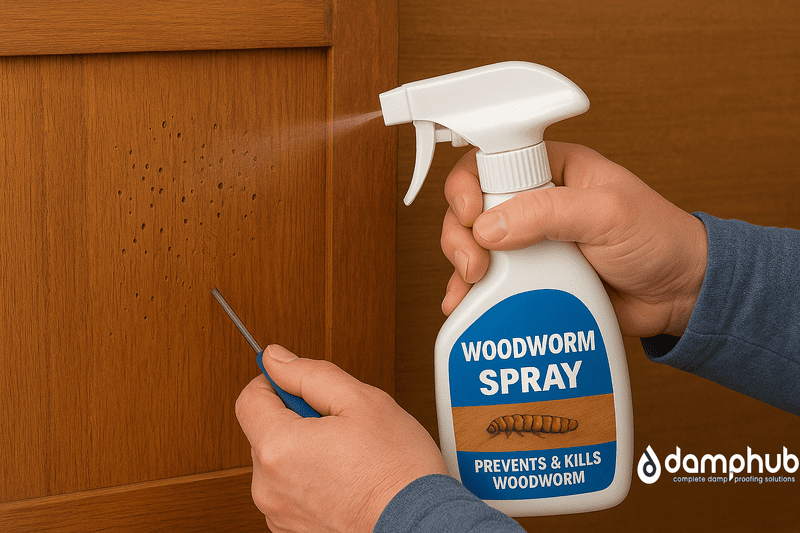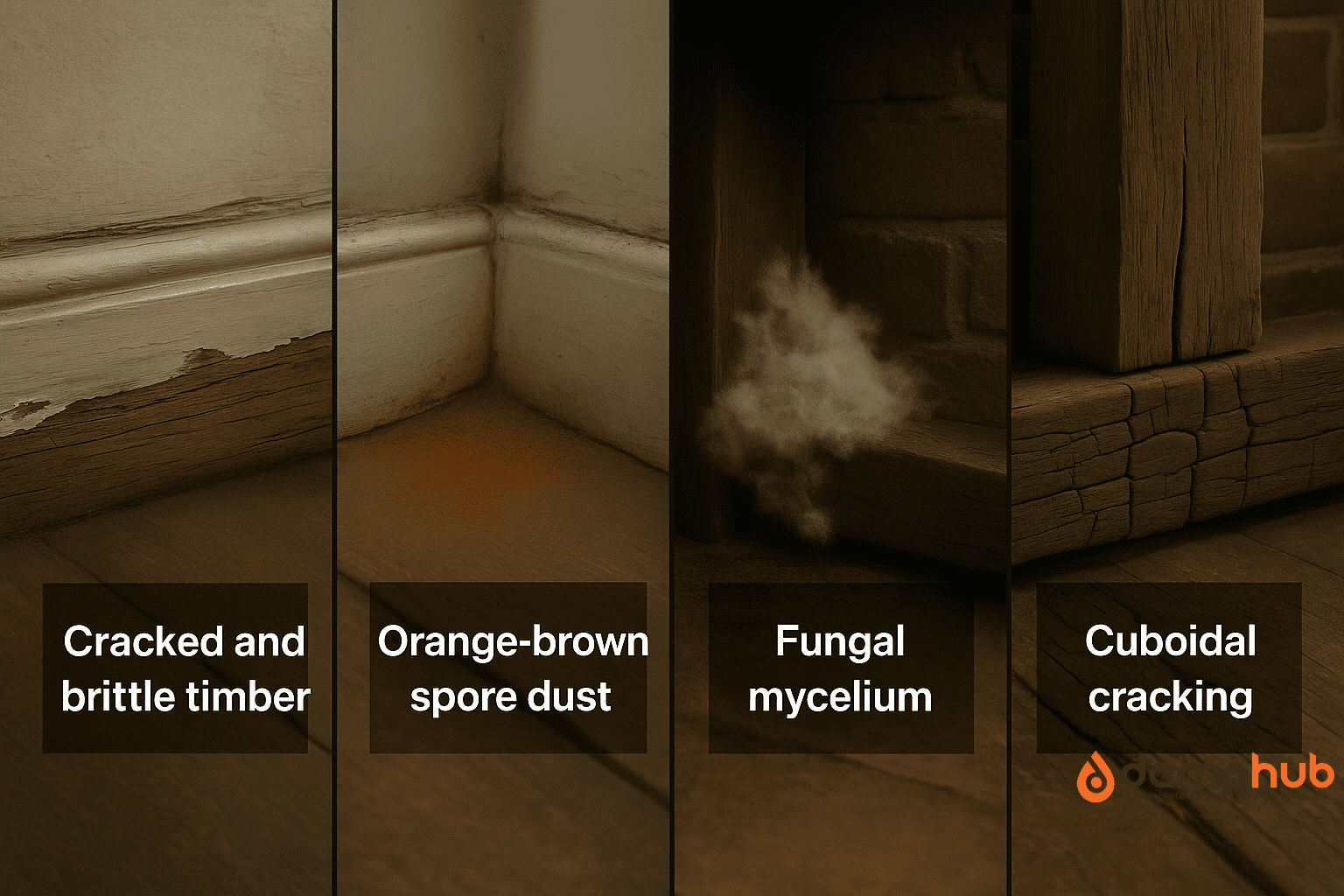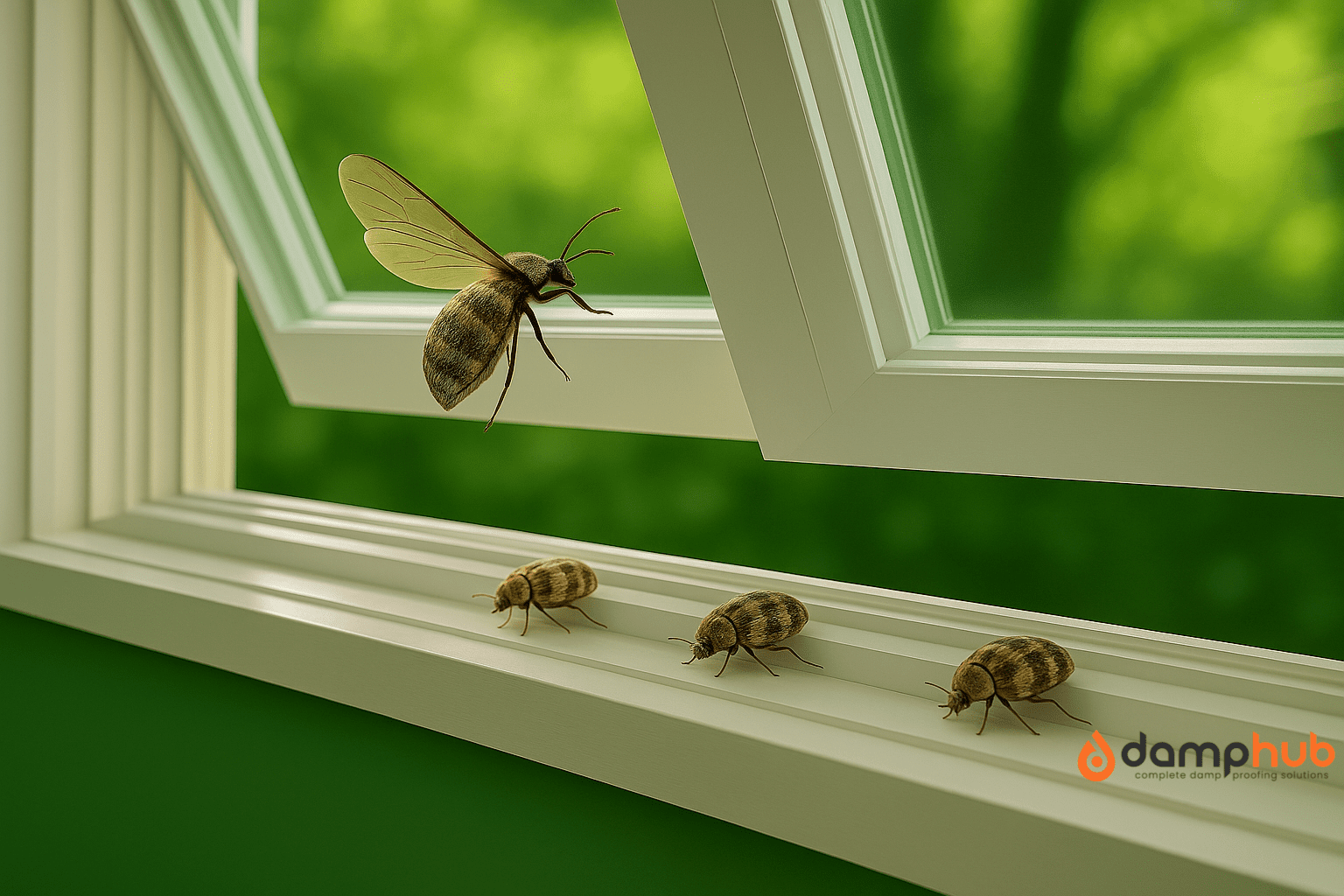
Key Takeaways
- ✓ Carpet beetles don’t bite – they trigger allergic reactions from larval hairs.
- ✓ The rash appears after contact with infested fabrics, not immediately.
- ✓ Only larvae cause skin issues – adult beetles are harmless.
- ✓ Symptoms often start after cleaning, moving rugs, or handling old clothes.
- ✓ The hairs linger in fabrics, causing flare-ups days later.
A carpet beetle rush is an allergic skin reaction caused by the tiny bristle-like hairs on carpet beetle larvae.
If you are waking up scratching, with red patches on your arm, back, or other parts of exposed skin, and have confirmed that you have no bed bugs in your home, carpet beetles could be the blame.
The rushes you are experiencing are a result of your immune system reacting to the irritants, especially after coming into contact with the fine, bristly hairs of the beetle larvae.
These fine, bristly hairs rub off as the larvae crawl through your clothes, bedding, or carpet. Once they touch your skin, boom—your immune system flips out.
And if you’re sensitive? That little reaction turns into a full-blown rash that sticks around.
Our other guide👉 How to Prevent Carpet Beetle Bites?
What Causes Carpet Beetle Rash?
Not bites. Not venom. It is the fine, bristly hairs of the beetle larvae.
They’re microscopic. But they’re brutal if your skin’s reactive.
Larvae shed them as they move. The hairs settle into soft furnishings like blankets or beddings, clothes, and your favourite clothes drawer.
You lie down on the bed, wear something woolly, and those hairs rub against your skin. The result? Itchy, blotchy chaos.
Even worse? The hairs hang around. You might get a rash days after the beetles are gone.
Good to Know:
The adult beetles don’t do this. It’s the larvae that leave the irritating hairs behind.
What Does Carpet Beetle Rash Look Like?
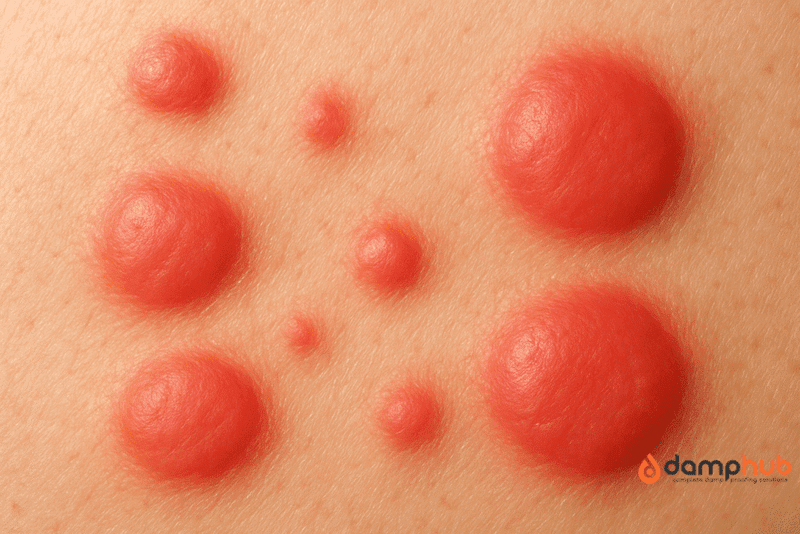
Carpet beetle rashes can catch you off guard. They don’t come with warning signs, and they often resemble other conditions, which is why so many people confuse them with dry skin, a heat rash, or even allergies.
But if you’ve recently been sorting old clothes, moving rugs, or clearing out corners you haven’t touched in months, and suddenly your skin’s flaring up, it’s worth paying closer attention.
Here’s what carpet beetle rash symptoms usually look like — and what sets it apart:
- Red, blotchy patches that don’t look quite right: You might notice scattered red marks or raised bumps. It’s rarely uniform. One bit might be more swollen or itchy than the rest, especially where skin brushes against an infested fabric.
- Itchy, but often with a delay: This isn’t like a mosquito bite where the itching starts straight away. With carpet beetle rash, it can take a few hours. You might feel a weird tingling or a warm patch before the itching kicks in properly.
- No bite marks, just angry skin: There’s no obvious dot or puncture in the centre — that’s a key difference. The rash isn’t from being bitten. It’s your body reacting to the fine hairs that carpet beetle larvae shed. Those hairs get caught in soft furnishings and stick to your skin without you realising.
- Often appears after you’ve done a deep clean: If the carpet beetle rash shows up just after hoovering the skirting boards, pulling furniture away from the wall, or going through storage bags — that’s a giveaway. Larvae love undisturbed areas, and when you shift things around, their hairs get kicked up into the air or onto your skin.
- Where it appears matters: Most people notice carpet beetle rashes on their arms, lower legs, or back. But it can show up anywhere your skin touches contaminated fabric, like sitting on an old blanket or wearing something pulled from the loft. Some even find it on their stomach or thighs after lounging on a sofa they hadn’t used in a while.
See our other guide: 👉 What Is Woolly Bear Carpet Beetle?
Who’s Most at Risk of Carpet Beetle Rash?
It can happen to anyone. But some folks are more likely to notice:
- People with eczema or generally sensitive skin
- Kids who spend more time on the floor
- Homes with wool, feathers, and natural fibres
- People who’ve just pulled old clothes out of storage
And here’s the thing—if you’re prone to hay fever or allergic to dust mites, your chances of reacting to these hairs go way up.

Pro Tip:
Don’t think you’re safe because you’re tidy! Carpet beetles love clean homes too. It’s not about dirt—it’s about access to fibres.
What are the Side Effects of Carpet Beetles Biting?
Quick reminder: carpet beetles don’t bite.
But their larvae cause skin reactions that some people confuse with a bite. Here are the side effects you might have to deal with:
- Red, swollen patches
- Itching that can wake you up at night
- Hives or a rash that spreads in weird patterns
- Sensitive eyes or a runny nose if the hairs go airborne
Some people get little blisters. Others get nothing more than a dry-looking patch. It really depends on how allergic you are to the hairs.
If you’ve ever reacted to pet dander, dust, or even certain fabrics, there’s a decent chance you’ll react to carpet beetle hairs too.
What to Avoid:
Don’t treat it like a bite. Bug sprays won’t solve this.
How Do I Know If I’m Allergic to Carpet Beetles?
Start by connecting the dots:
- Rash appears only after you’ve worn or touched certain fabrics
- You react after lying on a sofa, carpet, or bedding
- Cleaning or washing affected items makes the rash improve
- Antihistamines help it calm down quickly
If you’re reacting this way and there’s no visible bites, that’s your clue.
Some people don’t realise it for weeks. They try every lotion under the sun. But until the fabrics are cleaned and the larvae removed, the rash keeps flaring back up.
Read more here: 👉 How to Identify and Get Rid of Black Carpet Beetles
Pro Tip:
Keep a journal. Sounds boring, but it helps you spot patterns fast.
How Long Does a Carpet Beetle Reaction Last?
The carpet beetle reactions can last forever if you don’t remove the sources. However, if you remove the causes, the carpet beetle rash symptoms will usually fade within 2 to 7 days.
The thing is to make your bedding or clothes free from the fine, bristly hair. Otherwise, these hairs can keep re-triggering the rash every single day.
Tips that actually help:
- Wash everything at 60°C or more
- Hoover your mattress, cushions, and soft furniture
- Try antihistamines for itching
- Stick to loose, breathable cotton clothes
- Keep your skin moisturised
Some folks clear up in 48 hours. Others take over a week, especially if the rash was scratched raw.
Pro Tip:
Don’t: Keep sleeping on the same pillow without washing it. It’s one of the biggest culprits.
How to Treat Carpet Beetle Rash
Once you’ve figured out the rash is from carpet beetle larvae, the next step is sorting out your skin. It might look angry, but it’s usually harmless, and most people clear up without needing a GP. Still, the itching can drive you up the wall, so here’s what actually helps.
Caution:
This isn’t medical advice. If your symptoms are severe, spreading, or not improving after a few days, speak to your doctor or pharmacist.
1. Hydrocortisone Cream (1%)
This is your best bet for quick relief. It’s a mild steroid that helps reduce itching, redness, and swelling. You won’t see it on the shelf — just ask at the pharmacy counter, and they’ll usually hand it over.
Use a small amount, morning and night, for up to seven days.
Pro Tip:
Only use it on unbroken skin — if you’ve scratched until it’s raw, give it a rest or ask your pharmacist what’s safe.
Good to Know:
Using steroid creams for too long can thin the skin. Stop applying once the rash settles down.
2. Calamine Lotion
If the rash feels hot, sore, or irritated, calamine can help calm things down. It’s old-school but still effective — cools the skin, dries up mild weeping, and doesn’t leave a greasy film.
Dab it on gently a few times a day using cotton wool or a clean cloth. It’s mild enough for use on children or delicate areas.
Read more here: How to Prevent Carpet Beetle Infestation
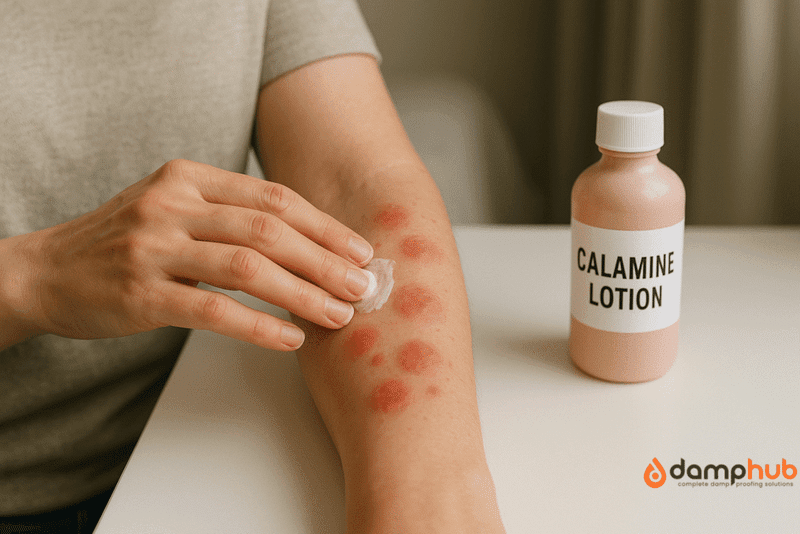
Good to Know:
You’ll find calamine in most chemists and supermarkets — often near baby products — and it’s cheap as chips.
3. Antihistamines
Sometimes it’s not just the rash. If you’re also sneezing, rubbing your eyes, or feeling itchy all over, your body might be having a broader allergic reaction. Antihistamines can help settle things.
- For small, localised rashes: Try an antihistamine cream like Anthisan or Benadryl Itch Relief.
- For widespread symptoms: Take a daily non-drowsy tablet like cetirizine or loratadine.
Pro Tip:
Take antihistamines at the same time each day. If the itching’s worse at night, ask your pharmacist about a drowsy option like chlorphenamine — it might help you sleep.
While It’s Clearing
Clearing the rash is one thing — keeping it from getting worse is another. These small steps can make a big difference:
- Avoid scratching — even gentle rubbing makes the rash last longer and can break the skin.
- Wash gently with cool water and a mild, fragrance-free soap. Skip hot showers — they’ll only make it sting.
- Avoid rich moisturisers or oils while the rash is active. They can trap heat and make things itchier.
Pro Tip:
Stick to loose, breathable clothing. Fabrics like cotton are ideal. Avoid anything tight, synthetic, or woolly — it’ll only irritate your skin further.
When to See the GP
Most reactions don’t need medical help.
But you should see someone if:
- The rash is spreading fast
- It’s blistering or leaking
- You feel unwell or feverish
- Swelling happens near your eyes or mouth
- You’ve cleaned and cleaned, but still keep reacting
Also worth booking a GP if your rash keeps returning, even after deep cleans. It could be a second issue, like contact dermatitis or a mild infection from scratching.
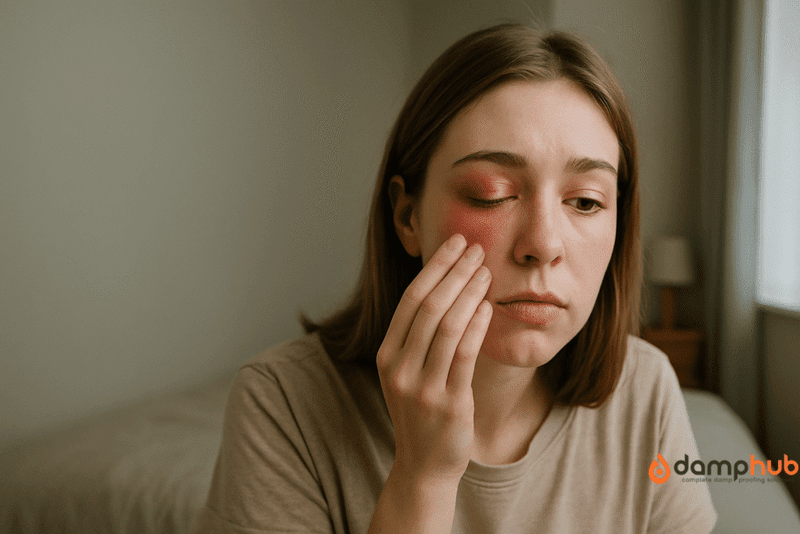
Good to Know:
If you’re booking a phone or video appointment, take a photo of the rash when it’s at its worst. It helps your doctor see what’s going on if it fades before they call.
How to Stop Carpet Beetle Rash From Coming Back
This is where most people give up too soon.
Luckily, here’s the winning combo:
- Vacuum every day for a week, especially soft furnishings
- Wash all bedding and clothes in hot water
- Steam clean carpets and sofas (if you can)
- Bag up woollens you’re not using and freeze them if possible
- Get into corners, cracks, under the bed, and behind radiators
Also, keep an eye on your wardrobe. Beetles love dark corners full of wool.
Pro Tip:
If you see tiny beetles flying near windows, that’s a sign they’re breeding somewhere inside.
Must Read: 👉 How to Get Rid of Carpet Beetles in the UK
What Is the Fastest Way to Get Rid of Carpet Beetles?
Speed matters when your skin’s inflamed.
Here’s your fast-action plan:
- Find the source—check carpets, wardrobes, and under furniture.
- Vacuum everywhere, including inside drawers.
- Wash all soft items at 60°C minimum.
- Use a carpet beetle-specific insecticide on baseboards and skirting.
- Repeat the process every 7–10 days for a month.
Carpet beetles lay eggs in cycles. Missing just one batch can restart the whole problem.
Good to Know:
Cedar, essential oils, and home remedies don’t cut it. Use proper insecticides.
What Can Be Confused with Carpet Beetle Rash?
Carpet beetle rashes don’t look that unusual, which is why they’re easy to get wrong. If you’ve never dealt with these pests before, you’d probably think it’s something else. The rash shows up as itchy, red patches or little bumps, and that could be a lot of things.
Here are the ones people mix it up with the most, and what to watch for:
1. Bed Bug Bites
This is the big one. Bed bug bites usually come in lines or tight clusters and tend to appear overnight. You might notice a tiny red dot in the middle of each one.
The difference:
Bed bugs bite. Carpet beetles don’t. The rash from carpet beetles comes from their hairs, not bites, and it shows up after touching certain fabrics or furniture, not just from sleeping.
2. Flea or Mite Bites
Fleas and mites can both cause small, itchy red marks. You’ll often see them around your ankles, waist, or lower legs. Flea bites often come in threes.
What to check:
Got a pet? Birds nesting nearby? Fleas or mites are more likely. Carpet beetles don’t feed on people — their hairs just trigger a reaction.
3. Contact Dermatitis
This rash shows up when your skin reacts to something it’s touched, like new laundry detergent, fabric softener, or synthetic clothing. It’s often red, itchy, and a bit inflamed.
Think back:
Used a new product? Wore something you haven’t before? It could be dermatitis. But if it’s happening near wool, feathers, or old rugs, carpet beetles are worth considering.
Read more here: What is a varied carpet beetle?
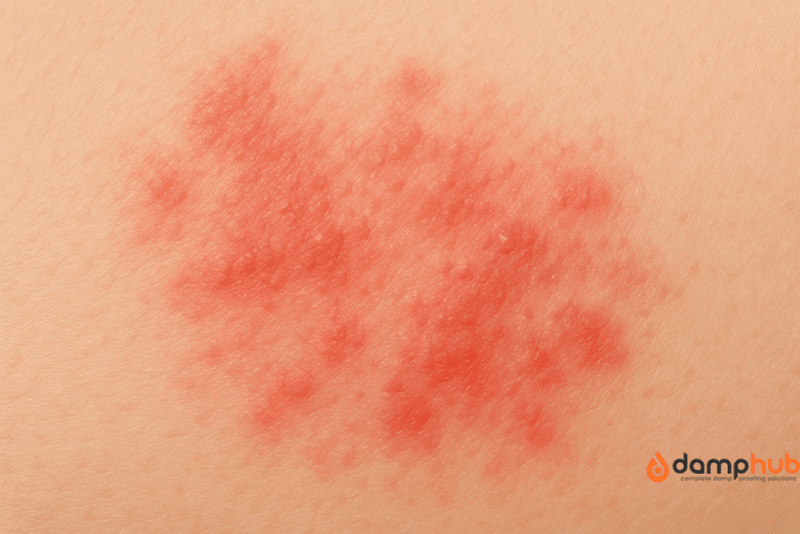
4. Heat Rash
Happens when you get hot and sweaty — blocked pores cause tiny red bumps that feel prickly. Shows up in summer or after exercise.
Worth noting:
If it came on after moving rugs, sorting old clothes, or cleaning a dusty loft — and you’ve spotted tiny fuzzy larvae — it’s probably not heat rash.
5. Scabies
Not as common, but it causes red, itchy spots, often between fingers or around wrists. It spreads easily and usually gets worse at night.
A red flag:
If more than one person in the house has the rash and the itching keeps getting worse, speak to a doctor. Carpet beetles don’t spread between people.
Still Not Sure? Look Around
If the rash flares up after cleaning, sorting clothes, or sitting on the sofa — and you’ve seen signs like gritty dust or strange fuzzy bugs — chances are, carpet beetles are behind it.
Still guessing? Read more here or get the room checked and speak to your GP. It’s the quickest way to know for sure.
Carpet Beetle Rash vs Other Common Skin Conditions
Here is a quick comparison of carpet beetle rashes vs other conditions with similar effects:
| Condition | Main Cause | Appearance | Common Areas | Key Difference |
|---|---|---|---|---|
| Carpet Beetle Rash | Allergic reaction to bristly hairs on larvae | Itchy red patches, bumps, or blotchy rash | Arms, legs, wherever larvae contact | Caused by contact — not bites; usually appears after cleaning or moving fabrics |
| Bed Bug Bites | Bites from live bed bugs | Red bumps, often in lines or clusters | Exposed areas during sleep (arms, neck, back) | Actual insect bites; usually appear overnight |
| Flea Bites | Bites from fleas (usually from pets) | Small red dots, often in groups of 3 | Ankles, legs, feet | Often around lower legs; linked to pet presence |
| Mite Bites | Mites (dust mites, bird mites) | Tiny red marks, sometimes hard to see | Any exposed skin | Often itchy at night; linked to birds or pets |
| Contact Dermatitis | Skin reaction to chemicals or allergens | Red, inflamed, sometimes dry or flaky skin | Hands, arms, anywhere touched | Caused by soaps, detergents, clothing fibres — not insects |
| Heat Rash | Sweat trapped in pores | Tiny red or pink bumps, itchy or prickly | Back, chest, neck, under clothes | Appears in hot weather or after sweating |
| Scabies | Mites burrowing under skin | Intense itching, red bumps or tracks | Between fingers, wrists, waistline | Very itchy at night; spreads between people through contact |
Final Thoughts
The rash messes with you. It looks like bites. It spreads. It keeps coming back.
But now you know better. It’s not in your head. It’s not dirty living. It’s not poor hygiene.
It’s hair. From a tiny, crawling thing you probably never saw.
Here’s your takeaway:
Read more here: What Does Woodworm Look Like?
Quick Action Steps
- ✓ Wash bedding and clothes at 60°C+ to remove allergenic hairs.
- ✓ Vacuum daily for a week, focusing on carpets, furniture, and corners.
- ✓ Apply 1% hydrocortisone or calamine lotion to soothe the rash.
- ✓ Take antihistamines to reduce itching and allergic response.
- ✓ Avoid tight, wool, or synthetic fabrics – wear loose cotton instead.
It’s fixable. The rash fades. You get your sleep back. And you stop second-guessing yourself every time you itch.
Simple plan. Solid results.
Answering Your Questions on How to Treat Carpet Beetle Rash

-
Can carpet beetles bite?
No, carpet beetles don’t bite. They don’t feed on humans or pets. But their larvae shed tiny, bristly hairs that can irritate your skin.
That’s what causes the red, itchy rash some people get — it’s an allergic reaction, not a bite.
-
Can carpet beetles live in your bed?
Yes, but it’s not common. Carpet beetles prefer dark, undisturbed places with natural fibres — like wardrobes, skirting boards, under furniture, or inside air vents.
But if your bed has wool, feathers, or natural fillings, they might nest in or around it. If you’re seeing larvae in bedding or mattresses, it’s time to deep clean and check nearby areas too.
-
Should I be afraid of carpet beetles?
Not afraid — but alert. Carpet beetles don’t harm you directly, but they can ruin clothes, rugs, curtains, and soft furnishings.
If left alone, they can spread quietly through your home and cause a lot of damage before you realise what’s happening.
-
Why have I got a carpet beetle?
Carpet beetles usually sneak in through open windows, vents, or on second-hand items.
Once inside, they lay eggs near natural materials like wool, leather, feathers, and pet hair.
If you’ve recently brought in vintage furniture, stored clothing, or haven’t cleaned under furniture in a while, they’ve likely found the perfect hiding spot.
-
How do you get rid of carpet beetles with baking soda?
Baking soda can help kill larvae and deodorise affected areas. Sprinkle it onto carpets, rugs, and cracks where larvae might be hiding.
Leave it overnight, then vacuum thoroughly.
While it won’t solve a big infestation on its own, it’s a good natural helper alongside other methods like deep cleaning and steam treatments.
-
Will apple cider vinegar get rid of carpet beetles?
It can help deter them, but it won’t kill larvae or eggs. You can mix apple cider vinegar with water and spray it on surfaces to help clean and repel adult beetles.
For best results, use it as part of a larger treatment plan, including vacuuming, washing fabrics, and sealing up entry points.

